| Image |
Type |
Built |
Qty |
Used |
Added |
Edited |
|
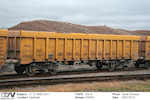 |
IEA/IOA Network Rail Bogie Box Wagons |
2009 |
160 |
2009-current |
15/10/2014 |
15/10/2014 |
|
Greenbrier built two batches of bogie box wagons for Network Rail in 2009. 120 were high-sided wagons coded IOA and used in block formations to deliver ballast to virtual quarries. The other 40 were low-sided IEAs, assigned to general infrastructure work alongside similar wagons of types JNA and MLA.
|
|
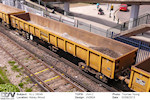 |
JNA 'Falcon' Bogie Ballast/Spoil Wagons |
2003-2004 |
555 |
2003-current |
01/10/2007 |
09/03/2008 |
|
A large fleet of 555 Romanian-built bogie open wagons was delivered to Network Rail in 2004 and they have since become a common sight across the country, carrying ballast and spoil in connection with infrastructure work. Nicknamed 'Falcons' (for reasons unknown) and painted in a distinctive all yellow livery, the wagons often operate in sets of five.
|
|
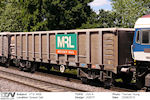 |
JNA Mendip Rail Bogie Aggregate Wagons  |
2000-2001 |
90 |
2000-current |
23/12/2007 |
08/04/2008 |
|
The large fleet of wagons used to haul stone from the Somerset quarries to London and the South East was partially renewed in 2000/2001 with the arrival of 90 rugged-looking box wagons built by Marcroft. These were the first to carry the logo of the recently formed Mendip Rail company, other types continuing with the Yeoman and Hanson brandings. They were also the first to use the TF25 low track force bogie.
|
|
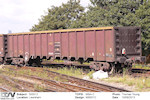 |
MBA/MCA/MDA/MOA Bogie Open Wagons  |
1999-2003 |
350 |
1999-current |
23/12/2007 |
16/05/2008 |
|
These large bogie open wagons were one of several types built by Thall at York Works as part of the reinvigoration of the freight fleet by EWS. Ironically, the big, American-looking MBAs turned out to be too large and many had their height cut-down fairly soon after delivery, to form types MCA and MDA. Further wagons were built to the reduced height (as MOAs), these being mainly used on infrastructure work alongside the MCA/MDA fleet, while the full-height MBAs eventually found employment on a wide variety of revenue flows.
|
|
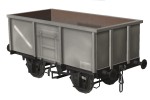 |
MCO/MCV 16t Mineral Wagons |
1944-1978 |
c.304372 |
1950-c.1992 |
01/01/2008 |
14/07/2008 |
|
What can you say about the humble BR 16 ton mineral wagon that hasn't been said before? How about the fact that, if made up into a single train, they would stretch over 1,100 miles! It is likely that they were never all in service at the same time of course, the building programme lasting from 1944 to 1959. The vast majority of BR 16 ton minerals had metal bodies with doors in the sides and one end (and in the floor on many), mounted on 9ft wheelbase underframes with plain bearings and unfitted Morton brake gear. The type survived in revenue use until the late 1980s, and a few years longer in departmental service.
|
|
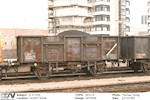 |
MDO/MDV/MEO 21/24½t Mineral Wagons |
1950-1978 |
13907 |
1950-c.1992 |
01/01/2008 |
01/07/2008 |
|
Although almost 14,000 of these larger mineral wagons were built for BR, they were overshadowed by the far more numerous 16ton variants. Two basic designs were used, both having twin side doors and one end door in their 21ft 6in long bodies, mounted on 12ft wheelbase underframes. The 24½t variant (MEO) was over a foot taller than the standard 16ton mineral, at over 9ft 10in. The 21ton wagons (MDO and MDV) were closer to the 16 tonners in height, and lasted longer both in production and in service. Rebodying in later years produced further variations. The South Wales coalfields were the types main area of operation and the last were withdrawn in about 1992.
|
|
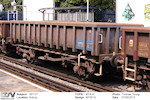 |
MEA/MFA Box Wagons  |
1990-2004 |
641 |
1990-current |
16/12/2007 |
12/09/2008 |
|
The MEA wagons were produced by rebodying redundant HEA coal hoppers with new box bodies. Intended originally for coal, the type has found use carrying a variety of bulk loads. A total of 641 wagons were converted, although before this was completed, 135 were cut-down for use as infrastructure wagons recoded MFA.
|
|
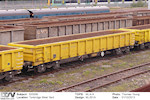 |
MLA Bogie Box Wagons |
2006-2008 |
245 |
2006-current |
15/10/2014 |
15/10/2014 |
|
The MLA code first appeared in 2006 and is applied to two batches of low-sided bogie box wagons used by three different operators. An initial batch of 140 yellow wagons was ordered by GB Railfreight for use on their Metronet contract, some being diverted to Network Rail. EWS followed this with 105 similar wagons but in a red livery. All are used for infrastructure duties.
|
|
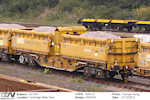 |
MRA Side-Tipping Ballast Wagons  |
2003-2004 |
400 |
2003-current |
1/1/2008 |
1/1/2008 |
|
Each MRA bogie ballast wagon has two shallow boxes which can be tipped to either side, discharging ballast onto parallel trackbeds. They operate in fixed rakes of 5 wagons, one of which is fitted with a generator to provide power and air to the whole set. The first 300 were delivered in a cream livery for use by Railtrack while a second batch of 100 was in yellow and branded Network Rail. 25 of the second batch were later transferred to GB Railfreight for use on the Metronet contract.
|
|
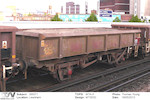 |
MTA Open Ballast Wagons  |
1998-2007 |
396 |
1998-current |
01/01/2008 |
26/07/2009 |
|
The MTA box wagon is a simple-looking type with a complicated history. Together with the similar but more numerous MFA and MHA types, the MTAs are used to carry ballast and spoil in connection with infrastructure works. The three types often work in mixed rakes and were responsible for replacing the last of the vacuum-braked Grampus wagons.
|
|
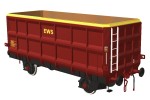 |
POA/SSA Scrap Metal Wagons |
1978-1984 |
181 |
1978-current |
1/10/2007 |
16/12/2007 |
|
A large number of open wagons for carrying scrap metal were built (or converted) during the 1980s. Perhaps the most distinctive were those owned by Standard Railfreight and painted in a bright blue and yellow livery. BR bought these wagons in 1990 and recoded them from POA to SSA. Most were eventually given new bodywork to a slightly revised design, and painted in EWS maroon. Although trialled on other traffics, the type continues in the main on scrap metal flows.
|
|
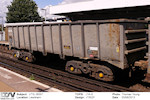 |
PTA/JTA/JUA Bogie Iron-Ore/Stone Tipplers |
1971-1977 |
458 |
1971-current |
1/12/2006 |
24/12/2006 |
|
Several large batches of these rugged bogie box wagons were built to convey iron-ore from ports to steel works in the 1970s. The changing fortunes of the steel-making industry has seen them lead interesting lives.
|
|
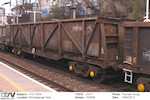 |
PX030 Sheerness Steel Bogie Steel/Scrap Wagons  |
1974 |
8 |
1974-current |
01/01/2008 |
12/04/2008 |
|
Although only 8 were built, these wagons were of interest in being among the first modern private-owner bogie steel wagons. In appearance they were similar to the BR-built BBA wagons but with higher ends. After just a few years service they were rebuilt as open wagons for carrying scrap metal, a role in which they continued following the end of traffic to Sheerness. A transfer to infrastructure duties was shortlived, having resulted in the derailment and withdrawal of 3 of the class.
|
|
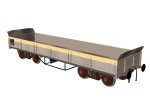 |
YCV 'Turbot' Bogie Ballast Wagons |
1982-1988 |
992 |
1982-2006 |
1/12/2006 |
24/12/2006 |
|
The Bogie Bolster E design built by BR in the 1960s turned out to be too short for their intended traffic but, when fitted with low-sided bodywork, found use as ballast wagons. Almost 1,000 were rebuilt in the 1980s and renumbered in the departmental series. Their vacuum brakes and relatively fragile drop-side doors saw the type displaced by more modern designs and conversions, and most of the Turbots were withdrawn in the late 1990s and early 2000s.
|
|
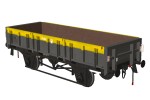 |
'Clam', 'Rudd' and 'Tope' Ballast Wagon Rebuilds  |
1984-1991 |
2069 |
1987-current |
01/01/2008 |
16/03/2010 |
|
The Clam, Rudd and Tope wagons were all rebuilds of HTV coal hoppers for use by the Civil Engineers. The Clam and Rudd conversions both involved the fitting of a new box body, the Rudds having dropside doors and air brakes. The Tope was a simpler job, merely having the original hopper body cut down in height and a solid floor fitted. The programme started in 1984 and, although scaled back, still involved over 2000 wagons, the vast majority of which appeared in the attractive grey and yellow livery. The vacuum braked Clam and Tope fleets were fairly rapidly withdrawn in the early 2000s, but the Rudds lasted longer, with over 200 still in use at the start of 2008.
|
|




















